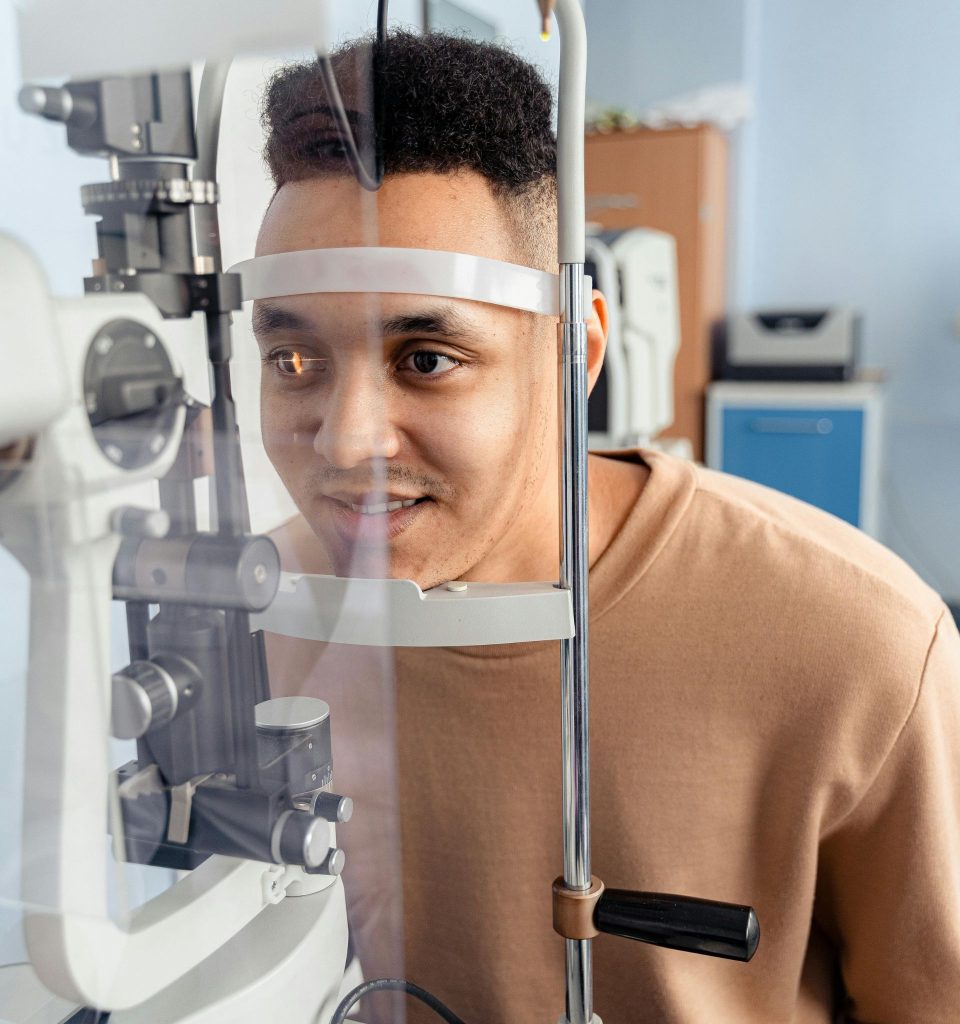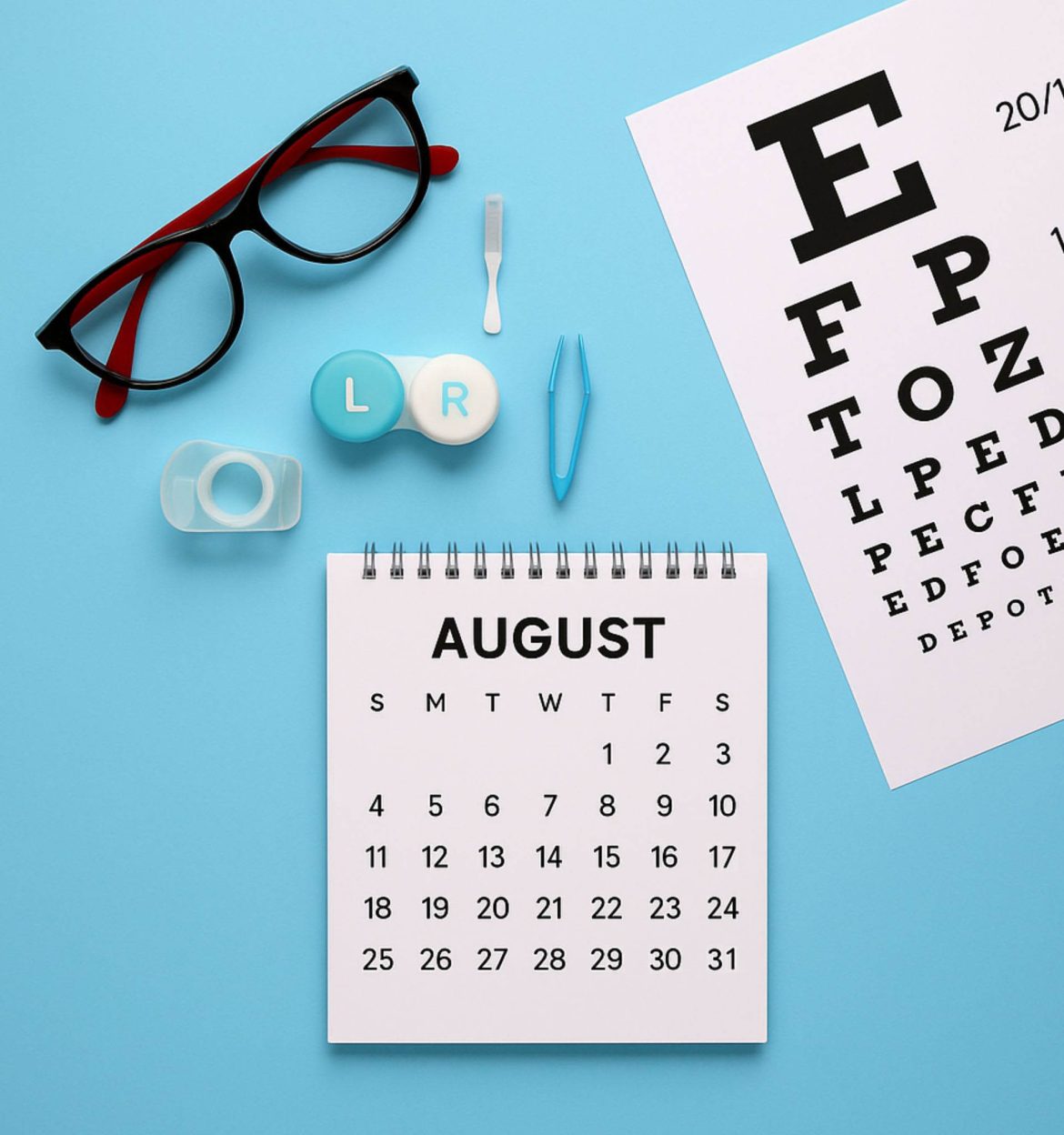![]()
National Eye Exam Month is coming soon! In the United States, it’s recognized every August, but it’s never too early to show your eyes some love.
Consider it a reminder from the ophthalmology profession for the general public: “Hey, let’s not forget our eyes, ok?”
Ready to learn a little more about eye examinations and caring for your eyes year-round?
The Importance of Eye Exams
For many, the eyes are neglected windows to the soul, speckled with dirt and dust (only metaphorically, I hope). Seriously, though, our eyes are often taken for granted, giving us a clear view of life, and getting nothing in return.
Think about it: You might only consider your eyes once they start failing you! That’s what happened to me. Years of reading with poor lighting and not eating right led to nearsightedness at a very young age. Now, I’m here to share the info you need not to make the same mistakes I did.
Regular eye exams and vision care are essential for the early detection of possible issues. You might think you’re in the clear if you have no noticeable symptoms, but an eye exam can help you be sure and let you know where your vision is right now so your doctor has a baseline.
Seeing an eye doctor gives you a chance to take action. When you know what’s going on with your eyes, you can do something about it.
What Do Eye Exams Test?

Comprehensive eye exams cover several aspects of your visual health.
- Acuity and Clarity: The doctor can assess your ability to see objects clearly at varying distances by having you read characters on an eye chart through a phoropter, which is a device with many different lenses.
- Refraction: You’ll probably be tested for nearsightedness, farsightedness, and astigmatism. These conditions are referred to as refractive errors, and they are typically addressed with corrective lenses.
- Eye Muscle and Movement: The optometrist will likely look for potential strabismus (misalignment) and other eye movement disorders.
- Intraocular Pressure: Tonometry tests the pressure inside your eyes to detect and manage glaucoma, which can damage your optic nerves.
- Pupil Response: Potential neurological issues can be determined by detecting whether your eyes properly dilate and contract in response to light.
- Inner Eye Health: The doctor may inspect various parts of the eye using a handheld ophthalmoscope or a specialized microscope called a slit lamp.
- Peripheral Vision: Your ability to see objects outside your central field of vision is often measured.
- Color Vision: You might be asked to identify colors so the doctor can diagnose color blindness or other related disorders.
- Retinal Imaging: Optical Coherence Tomography (OCT) is an advanced test that takes a detailed, cross-sectional picture of the retina to detect macular degeneration or other retinal conditions.
How Often Should You Get Eye Exams?
If you don’t have existing eye conditions that must be monitored or any family history of eye disease, high blood pressure, or diabetes, once every two years might work for you. Otherwise, you will need to go in for an exam more often.
Only an eye doctor can tell you how often is enough for you. Your ideal eye exam schedule depends on your age, existing eye conditions, and risk factors.
What Is Commonly Diagnosed Through Eye Exams?
Regular eye exams are fundamental for detecting eye problems early. Issues could be as common as myopia or as complicated as the degeneration of the macula (center of the retina). When you detect a problem early, corrective action may be more effective.
These are some of the conditions your eye doctor looks out for when doing an exam:
- Glaucoma is a group of eye diseases that damage the optic nerve. An Intraocular Pressure Measurement test checks for pressure inside the eye. The symptoms of this group of diseases can be subtle at the start, which is why early detection is crucial. Untreated glaucoma can lead to vision loss.
- Diabetic Retinopathy is a complication of diabetes where the retina’s blood vessels are affected. If untreated, it can lead to vision loss. If you have been diagnosed with diabetes or it runs in your family, you need to be very vigilant about getting regular eye exams.
- Dry Eye Syndrome: Dry eyes occur when the eyes don’t produce enough tears or the tears aren’t lubricating enough. While some people experience dryness upon waking, dry eyes are an ongoing problem for many patients. Treatment includes artificial tears (drops) and other therapies.
- Age-Related Eye Changes: Eye health declines with age. Take presbyopia, for example. This inability to focus on near objects is why so many patients over 40 need readers and bifocals.
- Cataracts cloud the eye’s lens. With time, the effects of cataracts generally include blurry vision and sensitivity to light. Once diagnosed, a doctor can prescribe treatment, including cataract surgery.
- Macular Degeneration involves the center of your retina (macula). If the health of your macula declines, your visual acuity decreases. Macular degeneration is largely age-related. Unfortunately, there is no cure, but there are treatments to slow its progress.
A Holistic Approach to Protecting Your Sight

Vision health isn’t just about a visit to the eye doctor during National Eye Exam Month or when you think you need a new prescription. A regular eye exam is a good place to start, but it’s much more than that. Caring for our eyes means incorporating positive practices involving diet, habits, and overall lifestyle changes.
Here are some strategies you should easily be able to incorporate into your daily life:
- Smoking Cessation: Smoking is a risk factor for eye conditions, such as optic nerve damage, cataracts, and macular degeneration. Quit smoking as early as you can.
- Protecting Your Eyes From the Sun: Ultraviolet radiation is super harmful. Long-term exposure can lead to cataracts and macular degeneration. Always wear protective sunglasses, which protect from 100% UVA and UVB rays.
- Eating Right For Better Sight: A balanced diet (fruits, vegetables, and omega-3 fatty acids) is excellent for eye health. Double down on your eye nutrition with food rich in lutein and zeaxanthin, such as leafy greens and eggs.
- Monitoring Blood Pressure and Blood Sugar: Your blood pressure and sugar levels affect your eye health. Keep these under control to try to prevent conditions such as diabetic retinopathy and other complications.
- Managing Your Digital Device/Blue Light Exposure: Modern digital devices cause eye strain, which can lead to more complicated conditions. Try to practice the 20-20-20 rule: Take breaks every 20 minutes and look at something 20 feet away for 20 seconds.
- Wearing Proper Eye Protection: Some circumstances expose our eyes to more risk. Whether you’re playing a fast-action sport or working with volatile materials, be sure to wear proper eye protection (e.g., UV protection, high-impact durability, complete eye coverage).
- Adequate Hydration: Always try to get enough water in your system, especially on hot days when you’re more likely to sweat. Something as simple as ample water intake can help with eye health and prevent dry eye syndrome.
National Eye Exam Month: Your Yearly Reminder To Care for Your Eyes
Let this be your wake-up call! Don’t put off making an appointment. You know National Eye Exam Month will be busy, so call and schedule an appointment today. Then, incorporate regular eye exams and the other vision health practices mentioned here into your wellness routine. Your eyes will love you for it!


